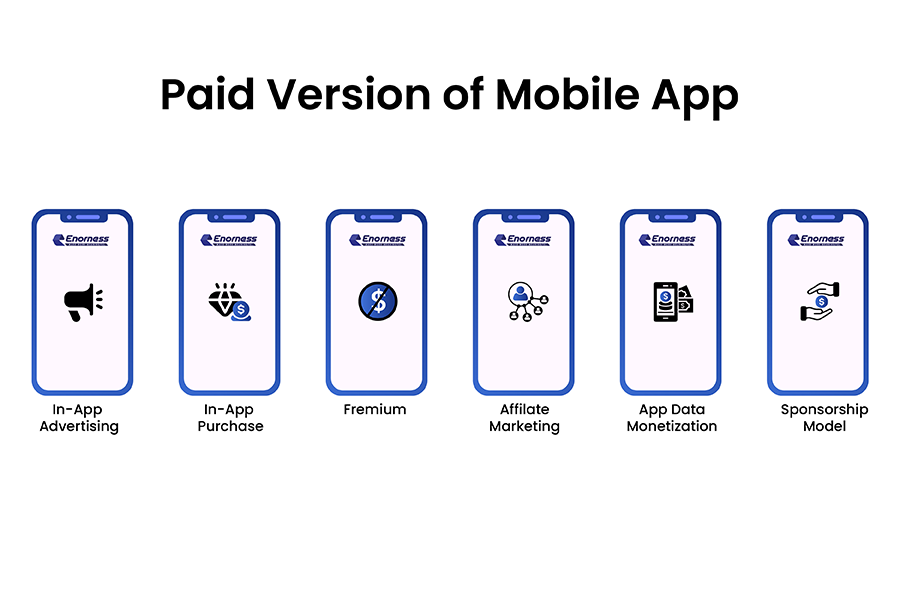The mobile application serves dual purposes, first in displaying content to your user. The second is to make money from mobile applications. Most developers need to get the right strategy for mobile app monetization. Your app has numerous potential revenue streams, but which monetization strategy aligns best with your content, target audience, and goals?
Different types of apps require tailored approaches to monetization—what works for a gaming app might not suit a news app. It’s essential to develop your mobile app development strategy accordingly. In this blog, we’ll tell you how phone apps make money and ways to mobile app monetization that businesses can use to make the most from their app.
What is Mobile App Monetization?
Mobile app monetization refers to the process of earning revenue through a mobile app. Various methods can be used to capitalize on an app’s user base, such as in-app advertising, in-app purchases, the freemium model, and more.
Top 7 Mobile App Monetization Strategies for Businesses and IT Firms

There are more than 2 million mobile applications on the iOS app store and more than 3.3 million phone apps on Google play store. In 2009, 77% of apps on the Apple App Store were paid, but today, only 4.9% require payment upfront. Similarly, paid apps make up just 3.01% of all mobile apps on the Google Play Store.
In today’s highly competitive market, app developers and publishers must keep up with the latest mobile app monetization strategies to maintain an edge.
Paid Mobile Apps
Paid mobile apps are one of the famous models of generating money from your developed phone app, it is known as a premium model. In this model, you can keep a fixed price of the application to download the app. So, every time users will download the application, they’ll pay you the price.
However, technology is changing and users nowadays are not opting for paid apps. As most apps are free today, a paid app must establish its unique value effectively to compete in the market.
In-App Purchases
Businesses can implement in-app purchases in monetized mobile apps to generate revenue from your phone app. With the in-app revenue model, the user purchases items, events, or content with the app post-installation.
Moreover, in-app purchases can help in enhancing the user experience. These strategies differ based on the app category—for example, upgrades in a productivity app, exclusive content in a fitness app, or items and unlocks in gaming apps, among others.
In-App Advertising
In the in-app advertising model, users are served third-party ads during app sessions and the publisher receives payment depending on the cost model used.
For example, rewarded video ads are a form of in-app advertising in which a user is rewarded for watching a full-screen ad. The reward can be an app currency, completion of a level, etc.
Freemium Models

The freemium model is the most popular model businesses and companies are using, this lets the user download the application and experience the free feature while reserving some important features for the paid users who will opt for the premium version of the mobile app.
Spotify and YouTube Music are prime examples of an app using the freemium pricing model. Users can download the app and access its content for free, supported by ads. Alternatively, they can opt for a monthly or yearly subscription to enjoy ad-free music and podcasts.
Affiliate Marketing
Affiliate marketing is a way of convincing your user to download the other mobile app or buy some products. You can partner with some businesses and promote their mobile apps or products and convince them to download their application. This way, every time a user will buy a product, you will generate revenue from it.
Also read: Six Critical Steps to Build a Mobile App That Shines
Sponsorship Model
Businesses can develop free mobile application and implement subscription models to it. Some developers adopt a subscription-based approach for free apps. In this model, the app is free to download but provides limited access to its content or services. To unlock full benefits, users must subscribe to a plan. This monetization strategy is popular among service-focused apps, such as the meditation app Headspace, and content-driven apps like news platforms.
This approach enhances discoverability in app stores, as the app appears as free when users search for relevant content. It’s an effective way for developers to attract an initial user base and convert them into paying subscribers.
Mobile App Data
First-party data has become increasingly valuable. This includes insights about your users, such as their demographics and in-app behaviors. Advertisers highly covet this data as it enables them to target their ideal audience more effectively.
As third-party cookies continue to decline in effectiveness, the demand for first-party data will only grow. Moving forward, collecting user data will be a cornerstone of most app monetization strategies.
However, data monetization tends to be most effective for publishers with a large and active user base. Without enough users to generate significant data, the collected information may hold limited value.
Also read: Mobile App Development Cost in 2025
Best Mobile App Monetization Platform
A mobile app monetization platform is a service or tool that helps app developers and publishers generate revenue from their apps. These platforms offer various monetization strategies, including in-app ads, in-app purchases, subscriptions, and more, tailored to the needs of the app and its audience. They often provide analytics and reporting tools to track performance and optimize revenue streams.
- Google AdMob
- Tapjoy
- Chartboost
- IronSource
- Revenue Cat
Conclusion
Overall, this is the answer to what is mobile app Monetization and how it can help you generate revenue from your mobile application. In Today’s world, mobile app Monetization is by far the best way to generate revenue if you implement it with proper strategy.







